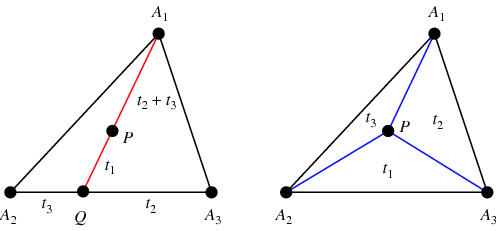Difference between revisions of "Barycentric coordinates"
(→Useful formulas) |
(→Useful formulas) |
||
| Line 64: | Line 64: | ||
<cmath>{k_a}^2x^2 + k_b^2y^2 + k_c^2z^2 - 2k_a k_b xy - 2k_a k_c xz - 2k_bk_cyz = 0,</cmath> where <math>k_a = b+c - a, k_b = a+c - b, k_c = a + b - c.</math> | <cmath>{k_a}^2x^2 + k_b^2y^2 + k_c^2z^2 - 2k_a k_b xy - 2k_a k_c xz - 2k_bk_cyz = 0,</cmath> where <math>k_a = b+c - a, k_b = a+c - b, k_c = a + b - c.</math> | ||
| + | The radical axis of two circles given by equations of this form is: | ||
| + | <cmath>k_1xa + l_1yb + m_1zc = k_2xa + l_2yb + m_2zc.</cmath> | ||
The point <math>P = (x : y : z)</math> is isotomically conjugate with respect to <math>\triangle ABC</math> with the point <math>P_1 =\left( \frac {1}{x} : \frac {1}{y} : \frac {1}{z}\right).</math> | The point <math>P = (x : y : z)</math> is isotomically conjugate with respect to <math>\triangle ABC</math> with the point <math>P_1 =\left( \frac {1}{x} : \frac {1}{y} : \frac {1}{z}\right).</math> | ||
The point <math>P = (x : y : z)</math> is isogonally conjugate with respect to <math>\triangle ABC</math> with the point <math>P_2 | The point <math>P = (x : y : z)</math> is isogonally conjugate with respect to <math>\triangle ABC</math> with the point <math>P_2 | ||
=\left( \frac {a^2}{x} : \frac {b^2}{y} : \frac {c^2}{z}\right).</math> | =\left( \frac {a^2}{x} : \frac {b^2}{y} : \frac {c^2}{z}\right).</math> | ||
Revision as of 14:59, 25 August 2023
This can be used in mass points. http://mathworld.wolfram.com/BarycentricCoordinates.html This article is a stub. Help us out by expanding it.
Barycentric coordinates are triples of numbers ![]() corresponding to masses placed at the vertices of a reference triangle
corresponding to masses placed at the vertices of a reference triangle ![]() . These masses then determine a point
. These masses then determine a point ![]() , which is the geometric centroid of the three masses and is identified with coordinates
, which is the geometric centroid of the three masses and is identified with coordinates ![]() . The vertices of the triangle are given by
. The vertices of the triangle are given by ![]() ,
, ![]() , and
, and ![]() . Barycentric coordinates were discovered by Möbius in 1827 (Coxeter 1969, p. 217; Fauvel et al. 1993).
. Barycentric coordinates were discovered by Möbius in 1827 (Coxeter 1969, p. 217; Fauvel et al. 1993).
The Central NC Math Group published a lecture concerning this topic at https://www.youtube.com/watch?v=KQim7-wrwL0 if you would like to view it.
Useful formulas
Let the triangle ![]() be a given triangle,
be a given triangle, ![]() be the lengths of
be the lengths of ![]()
We use the following Conway symbols:
![]() is semiperimeter,
is semiperimeter, ![]() is twice the area of
is twice the area of ![]()
![]() where
where ![]() is the inradius,
is the inradius, ![]() is the circumradius,
is the circumradius,
![]() is the cosine of the Brocard angle.
is the cosine of the Brocard angle.
![]() For any point in the plane
For any point in the plane ![]() there are barycentric coordinates:
there are barycentric coordinates:
![]()
![]() The normalized (absolute) barycentric coordinates NBC satisfy the condition
The normalized (absolute) barycentric coordinates NBC satisfy the condition ![]() they are uniquely determined:
they are uniquely determined:
![]() Triangle vertices
Triangle vertices ![]()
The barycentric coordinates of a point do not change under an affine transformation.
The straight line in barycentric coordinates (BC) is given by the equation ![]()
The lines given in the BC by the equations ![]() and
and ![]() intersect at the point
intersect at the point
![]()
These lines are parallel iff ![]()
The sideline ![]() contains the points
contains the points ![]() its equation is
its equation is ![]()
The line ![]() has equation
has equation ![]() it intersects the sideline
it intersects the sideline ![]() at the point
at the point ![]()
Iff ![]() then
then ![]()
Let NBC of points ![]() and
and ![]() be
be ![]()
Then the square of distance ![]()
![]() The equation of bisector of
The equation of bisector of ![]() is:
is:
![]()
Any circle is given by an equation of the form ![]()
Circumcircle contains the points ![]() the equation of this circle:
the equation of this circle: ![]()
The circumcenter ![]() lies at the intersection of the bisectors
lies at the intersection of the bisectors ![]() and
and ![]() its BC coordinates
its BC coordinates ![]()
The incircle contains the tangent points of the incircle with the sides:
![]()
The incenter is ![]() The equation of the incircle is
The equation of the incircle is
![]() where
where ![]()
The radical axis of two circles given by equations of this form is:
![]() The point
The point ![]() is isotomically conjugate with respect to
is isotomically conjugate with respect to ![]() with the point
with the point ![]()
The point ![]() is isogonally conjugate with respect to
is isogonally conjugate with respect to ![]() with the point
with the point ![]()










